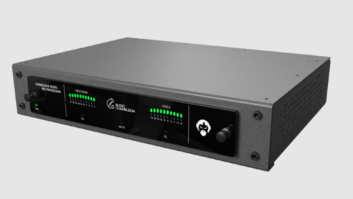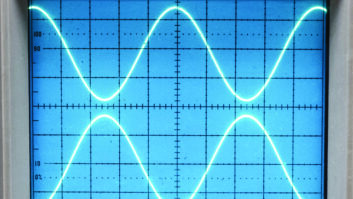It all started one Saturday morning a few weeks ago when my wife was lying in bed and wanted to listen to some music on her phone. She reached for the earbuds on her bedside table and discovered they had been a delectable snack for our 6-month-old kitten, Abby.
“DANA!” she said in a voice I’m sure that we have all heard our significant others use before. “I WANT A STEREO IN THE BEDROOM, that I can play my phone through and that does not require a wire between my phone and it!”
I shrugged, then nodded my head in the affirmative.
We did have speakers and a T-amp on the bedroom TV set, but I decided that I wanted to do something a bit friendlier for her. It obviously needed Bluetooth, but adding the ability to plug my laptop into the speakers (the laptop doesn’t have Bluetooth) would be cool, and FM wouldn’t be bad either. The dresser by my side of the bed seemed to be the right place to put this, as the laptop was already there (I sit on the side of the bed and use the laptop with it on the dresser).
I had a pair of fairly efficient Athena AS-B1 speakers sitting in a cabinet in the office. Hmm … they’re pretty small — or so I thought until I got them and put them on the dresser. Their presence left very little space for an audio unit. “Uh oh,” thought I, “What do I do now?”
THE EYE OF THE KENTIGER
I went to Amazon.com and searched for a Bluetooth amplifier. The first unit that popped up was a unit marketed by a company called Sally Best: “The SallyBest® USB SD DVD FM Audio Stereo Radio MP3 Speaker Car Bluetooth Amplifier HiFi Mini 2 amplifier” — with a price of $21.99! What a mouthful, I thought to myself. Besides, how good can this be for $22 shipped (free shipping with Amazon Prime)? I clicked on the link anyway and found that it was actually a Kentiger HY-502S. It was available all over the place and the reviews were surprisingly good! I bit, and two days later it came. It’s tiny and even has a remote control. I set the amplifier atop the right speaker. It requires a 12-volt power supply, minimum 5 amps. I already had a 6-amp switching supply bought from Amazon a while back for $8. I hooked it up, plugged it in and was pleasantly surprised — about the sound that is …
THOSE LIGHTS! THOSE AWFUL LIGHTS!

Fig. 1: The Kentiger box doesn’t do justice to the bright blinking LEDs. As Fig. 1 shows, the unit has a series of eight colored LEDS on its front panel. They blink random patterns and they are bright! Bright enough to make the bedroom look like a disco late at night with the other lights off. Even worse, as they flashed, I could hear a slight “clicking” in the speakers with the phone audio paused. These lights had to go! I opened up the back of the unit (seven screws — don’t remove the two antenna ones) and found that the light display plugged into the main board with a plug. Out the plug went and no more light show, thankfully. The clicking also went way and the unit was silent. The WAF (Wife Acceptance Factor) on the unit went up immensely. Its Bluetooth immediately paired with her phone and she was enjoying her tunes, sans earbuds. Its remote control works pretty well too.
CURIOSITY OVERWHELMED THE DANA
This unit is a huge bargain at $22! It sounds pretty good too — with a solid Bluetooth inside, a reasonable- sounding digital FM stereo tuner, sockets to play MP3 audio files from SD cards and USB sticks, and even a line input for the computer. I left it running for a week and my wife loves it. She even streams New Age music softly at night with it. The Athena speakers sounded pretty good too. BUT … frankly, I have heard them sound a lot better before. The desire to open this unit all the way up and see what I could do to improve its sound became overwhelming, so I did just that.
Turns out it was a very wise choice. The unit comes apart easily — just the seven screws mentioned, plus four on the front and two on the side. It uses an analog power IC amp (similar to the ones used in car stereos) and a 4558 op amp for the tone control. So far, pretty good — but not great. When I turned the circuit board over the first thing I noticed is that the ground and the power on the unit are (correctly) capacitor bypassed and the board traces are in a star configuration — but the traces from the power connector to the star are much too small — remember this unit calls for a 5-amp, 12-volt supply.
ANOTHER ONE RIDES THE BUS (BAR)

Fig. 2: The bottom of the Kentiger circuit board showing the new 18 gauge “bus bars” and capacitors. The blue cap on the left is for the new NE5532, the cap on the right is for the audio amp IC. To fix this, I took some 18-gauge solid wire and soldered it along the ground trace. This should make the ground a lot stiffer than it was. Next, I discovered there’s a large isolation (polarity) diode in series with the positive supply to protect the unit from a reversed power supply. The unit uses the center pin positive standard — just like 99 percent of today’s equipment that uses a wall plug transformer. Unfortunately, that diode also does two bad things: It drops the power supply half a volt and also increases its impedance. It had to go, so I ran a piece of red 18-gauge solid wire directly from the input power connector to the power switch, and then I cut one lead of the diode. Next, the voltage goes to a 1500 uF 25-volt capacitor. I had bought some 3300 uF caps for another project and had one left over, so it went in place of the 1500 uF one. Is this necessary? Probably not, but it will provide a bigger reservoir for the power amp IC. What’s interesting is the silk screening on the circuit board shows that a 2200 uF capacitor was supposed to go here, not the 1500 uF that was there.
I next traced the DC power to the audio power IC chip and found that it went through a tiny wire jumper atop the board (J4), which I cut and then ran an 18-gauge wire from the new, big capacitor directly to the IC. I also put a small metal film capacitor directly in between the power and ground pins of the IC. Radio Shack sells a 0.1 uF metal film capacitor that is ideal for this, though the value is not critical and can be anything from 0.1uF to 0.47 uF. See Fig. 2 for more detail — you should be able to determine all the necessary circuit changes from the picture.

Fig. 3: The new IC socket, the NE5532, the cut diode and the unplugged light show connector. AWAY WITH YOU, 4558 IC
The RC 4558 was a great audio IC — back in 1975, that is. During the 1980s, it was replaced by a much better one the NE5532. Since most broadcast equipment uses this IC, I’m sure that every one of you knows it well, so just install it in place of the 4558, OK? I also installed a socket for the NE5532. On the bottom of the board I soldered another 0.1 uF metal film capacitor from pin 8 (positive power) to the nearest ground (see above). I used a Radio Shack capacitor this time so you know what it looks like if/when you go there. Fig. 3 shows the top of the board with its new IC socket, the NE5532, the cut diode and the unplugged light show connector.

Fig. 4: The new shielded cable for the FM antenna. Look over each and every solder connection on the circuit board and fix any cold ones you happen to find. I recommend this because I found a few in mine.
Finally, as seen in Fig. 4, I replaced the red antenna wire inside the unit that runs to its whip antenna with a shielded cable. It seemed to make the FM audio a bit quieter. I also used premium heatsink compound on the power IC.
WHAT’S THE FREQUENCY KENNETH … ER … DANA?
I know what you are trying to ask: How does it sound? Far better! Before, the bass was present but “soft” sounding; now it grabs the speakers and forces their woofer cones to make bass! The high frequencies are similarly improved — they now sound “real.” The stereo separation is improved. The unit also seems to play louder also. What I will say is that it does not sound like a $22 stereo — more like a $220 one! It does have one quirk: I discovered that the line-in RCA jacks are backwards — red is left and white is right. The TRS jack seems correct though.
IT’S GETTING BETTER ALL THE TIME
Can this unit be improved further? Yes! There are a bunch of electrolytic capacitors that the audio runs through, and every one could be bypassed with a 0.1 uF metal film capacitor. The audio outputs of the power IC also run through a bunch of those small jumpers like J4 and these could be upgraded. You could also pull line-level audio out of the unit from across its volume control — and use a more powerful amplifier. The whip antenna could easily be replaced with a longer one, an ideal length would be around 18 inches, thus improving FM reception. The power supply can be safely increased to as high as 16 volts, increasing output power. And, if you like them, the LEDs can be turned back on!
ANY LAST WORDS?
This thing is a bona fide bargain, and “defective in the door” units are a part of life with units such as these. My advice is to run the unit completely stock for a week or so before you do any modifications. Try every feature, even if you don’t plan to use them now. Amazon is very good about replacing defective units, so don’t hesitate to return it if it’s not perfect.
I hope you enjoy your bargain audio unit … now I think I’ll hook those lights back up and play some Disco Inferno — burn, baby, burn! … Well, no, maybe not.
Dana Puopolo is chief engineer at WGLS(FM), Rowan University in Glassboro, N.J. Comment on this or any article to [email protected].












